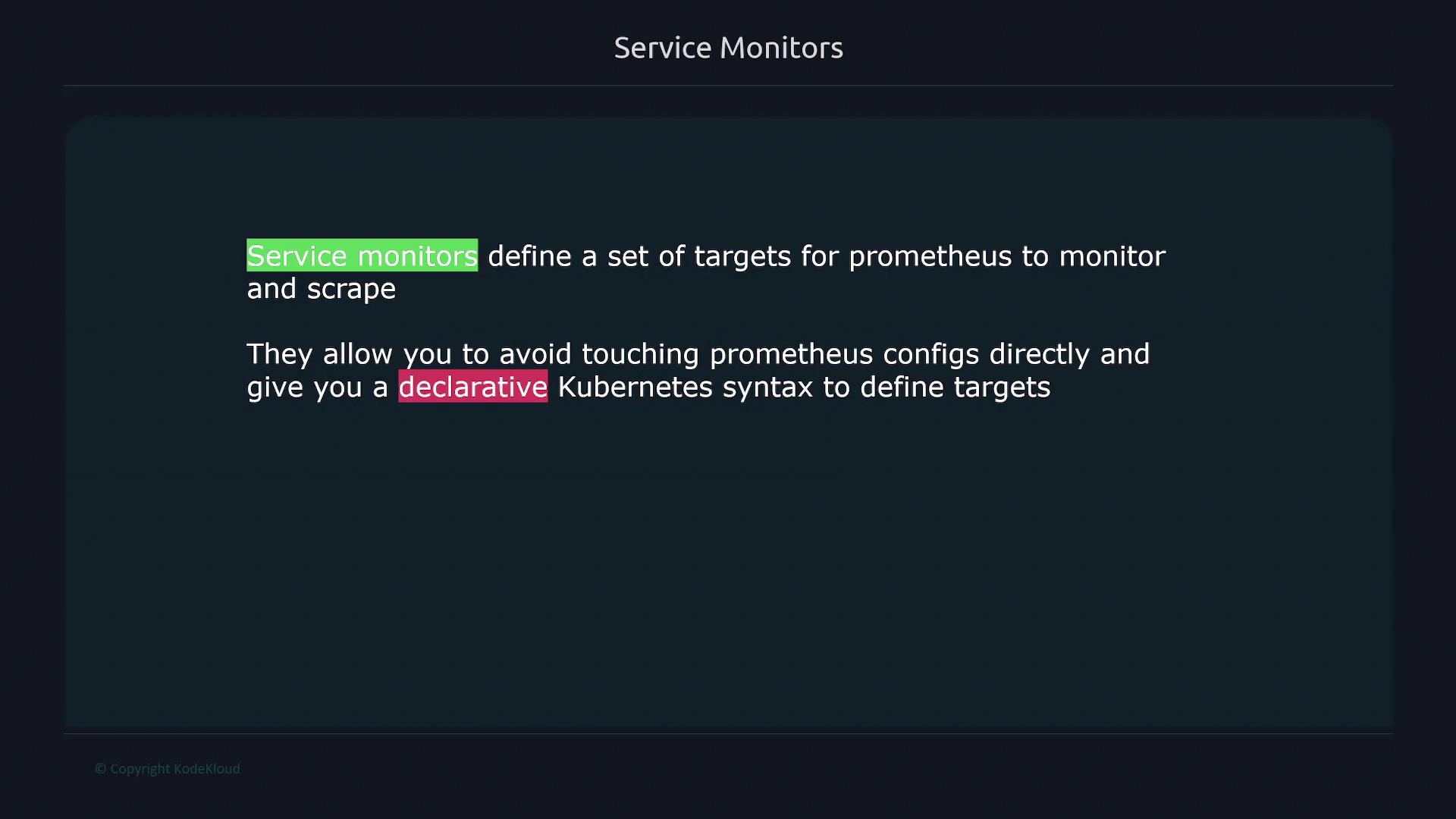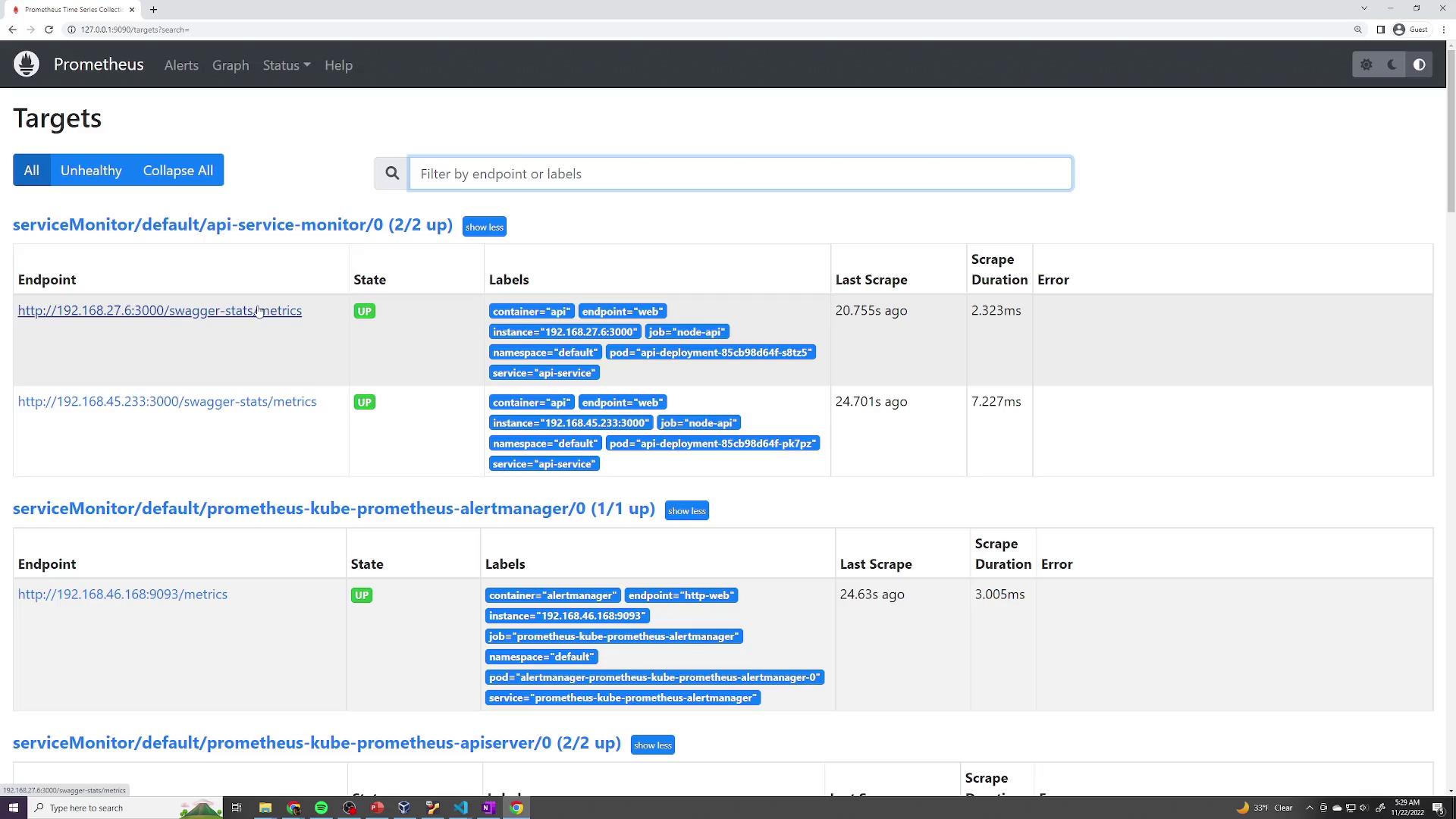Prometheus Certified Associate (PCA)
Monitoring Kubernetes
Service Monitors
This guide demonstrates how to add new scrape targets to Prometheus using the ServiceMonitor custom resource. Leveraging Kubernetes Custom Resource Definitions (CRDs) allows you to declaratively configure Prometheus to automatically discover and scrape new endpoints—no manual configuration updates necessary.
Understanding Custom Resource Definitions (CRDs)
The Prometheus Operator deploys several CRDs to provide a high-level abstraction for deploying and configuring Prometheus. Key CRDs include those for AlertManager, Prometheus, and ServiceMonitor. To list all available CRDs, run:
kubectl get crd
Sample output:
NAME CREATED AT
alertmanagerconfigs.monitoring.coreos.com 2022-11-18T01:18:55Z
alertmanagers.monitoring.coreos.com 2022-11-18T01:18:55Z
eniconfigs.crd.k8s.amazonaws.com 2022-11-18T01:04:11Z
podmonitors.monitoring.coreos.com 2022-11-18T01:18:56Z
probes.monitoring.coreos.com 2022-11-18T01:18:56Z
prometheuses.monitoring.coreos.com 2022-11-18T01:18:57Z
prometheusrules.monitoring.coreos.com 2022-11-18T01:18:56Z
securitygrouppolicies.vpcresources.k8s.aws 2022-11-18T01:04:14Z
servicemonitors.monitoring.coreos.com 2022-11-18T01:18:57Z
thanostruers.monitoring.coreos.com 2022-11-18T01:18:57Z
The ServiceMonitor CRD is particularly important because it enables you to define additional scraping targets (jobs) for Prometheus. Every ServiceMonitor is handled by Prometheus like any other Kubernetes resource.
What Is a ServiceMonitor?
A ServiceMonitor resource specifies a set of targets for Prometheus to monitor and scrape. Instead of manually editing the Prometheus configuration, you can use Kubernetes' declarative syntax. When a ServiceMonitor is created, Prometheus discovers it via its selector settings and automatically begins scraping the defined endpoints.

Using ServiceMonitors, you can automatically associate Kubernetes Services with Prometheus scrape configurations through label selectors. This many-to-one mapping streamlines the process of updating endpoints, avoiding the need to revise Prometheus configuration files each time a new endpoint is added.
For instance, if you have deployed an application with an associated Kubernetes Service, simply create a ServiceMonitor that references it to include its endpoints in Prometheus’ scrape targets.
Deploying a Service and ServiceMonitor
Below is an example configuration for deploying a Kubernetes Service and a corresponding ServiceMonitor for an API.
Kubernetes Service Definition
# service.yml
apiVersion: v1
kind: Service
metadata:
name: api-service
labels:
job: node-api
app: service-api
spec:
type: ClusterIP
selector:
app: api
ports:
- name: web
protocol: TCP
port: 3000
targetPort: 3000
ServiceMonitor Definition
# Service-monitor.yml
apiVersion: monitoring.coreos.com/v1
kind: ServiceMonitor
metadata:
name: api-service-monitor
labels:
release: prometheus
app: prometheus
spec:
jobLabel: job
endpoints:
- interval: 30s
port: web
path: /swagger-stats/metrics
selector:
matchLabels:
app: service-api
Key Points
- Labels and Selectors:
The ServiceMonitor’sselector.matchLabelsfinds services with the labelapp: service-api. Ensure your Service definition matches this label. - Endpoint Configuration:
The specified endpoint in the ServiceMonitor defines a 30-second scrape interval, uses the port namedweb, and sets the metrics path to/swagger-stats/metrics(customize as needed). - Job Label Mapping:
ThejobLabelproperty maps thejoblabel from your Service resource (e.g.,job: node-api) which Prometheus uses as the job name.
Integrating ServiceMonitor with Prometheus
Prometheus auto-discovers ServiceMonitor resources by using selectors. In the Prometheus custom resource (CR) YAML, you can see a configuration like:
kubectl get prometheuses.monitoring.coreos.com -o yaml
Excerpt from the Prometheus configuration:
serviceMonitorNamespaceSelector: {}
serviceMonitorSelector:
matchLabels:
release: prometheus
This instructs Prometheus to include any ServiceMonitor with the label release: prometheus in its target list. Ensure that your ServiceMonitor resource carries this label for successful integration.
Applying the Configuration
After updating your deployment configuration (such as in api-depl.yaml), apply your changes using:
kubectl apply -f api-depl.yaml
Sample terminal output:
Documents\scratch\example> kubectl apply -f api-depl.yaml
deployment.apps/api-deployment unchanged
service/api-service unchanged
servicemonitor.monitoring.coreos.com/api-service-monitor created
Documents\scratch\example took 2s
To list all ServiceMonitors, execute:
kubectl get servicemonitor
You will see your newly created ServiceMonitor along with any others deployed via Helm charts or alternate methods.
Verifying in Prometheus
After deployment, open the Prometheus UI and navigate to Status → Targets. Your API ServiceMonitor should be listed, indicating that Prometheus is scraping it according to the defined settings.

Additionally, running a query such as job="node-api" in Prometheus will help verify that the metrics are being collected from the API service.
Reviewing the Final Prometheus Configuration
For an in-depth review, you can inspect the generated Prometheus scrape configuration. This shows that ServiceMonitor settings—including metrics_path, scrape_interval, and relabeling configurations—have been correctly applied. Here’s an excerpt from the generated configuration:
scrape_configs:
- job_name: serviceMonitor/default/api-service-monitor/0
honor_timestamps: true
scrape_interval: 30s
scrape_timeout: 10s
metrics_path: /swagger-stats/metrics
scheme: http
follow_redirects: true
enable_http2: true
relabel_configs:
- source_labels: [job]
regex: (.*)
target_label: __tmp_prometheus_job_name
replacement: $1
action: replace
- source_labels: [__meta_kubernetes_service_label_app, __meta_kubernetes_service_labelpresent_app]
separator: ";"
regex: (api);true
replacement: $1
action: keep
- source_labels: [__meta_kubernetes_endpoint_port_name]
separator: ";"
regex: web
replacement: $1
action: keep
# Additional relabel configs...
This configuration confirms that labels, endpoints, and relabeling rules are effectively facilitating target discovery by Prometheus.
Summary
In this lesson, you learned how to:
- Leverage Kubernetes CRDs to extend Prometheus functionality.
- Create a ServiceMonitor resource to define additional scrape targets.
- Align your Kubernetes Service labels with ServiceMonitor selectors.
- Verify that Prometheus dynamically scrapes newly added endpoints without manual configuration updates.
By following these practices, you can maintain a scalable and declarative monitoring setup for your Kubernetes applications.
For further details, check out the following resources:
Watch Video
Watch video content